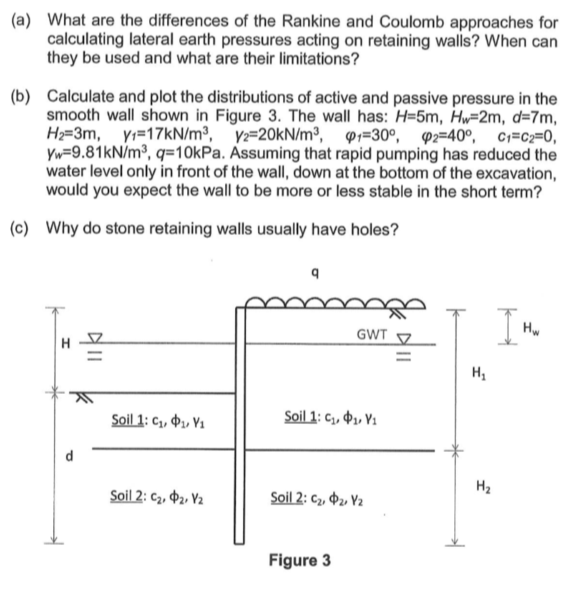Home /
Expert Answers /
Civil Engineering /
a-what-are-the-differences-of-the-rankine-and-coulomb-approaches-for-calculating-lateral-earth-p-pa917
(Solved): (a) What are the differences of the Rankine and Coulomb approaches for calculating lateral earth p ...
(a) What are the differences of the Rankine and Coulomb approaches for calculating lateral earth pressures acting on retaining walls? When can they be used and what are their limitations? (b) Calculate and plot the distributions of active and passive pressure in the smooth wall shown in Figure 3 . The wall has: \( H=5 \mathrm{~m}, H_{w}=2 \mathrm{~m}, d=7 \mathrm{~m} \), \( \mathrm{H}_{2}=3 \mathrm{~m}, \quad \gamma_{1}=17 \mathrm{kN} / \mathrm{m}^{3}, \quad \gamma_{2}=20 \mathrm{kN} / \mathrm{m}^{3}, \quad \varphi_{1}=30^{\circ}, \quad \varphi_{2}=40^{\circ}, \quad c_{1}=c_{2}=0 \), \( y_{w}=9.81 \mathrm{kN} / \mathrm{m}^{3}, q=10 \mathrm{kPa} \). Assuming that rapid pumping has reduced the water level only in front of the wall, down at the bottom of the excavation, would you expect the wall to be more or less stable in the short term? (c) Why do stone retaining walls usually have holes?
Expert Answer
a) Difference between the Rankine and coulomb earth pressure theories: Rankine earth pressure theory: 1. In this rankines considered real, frictionles
